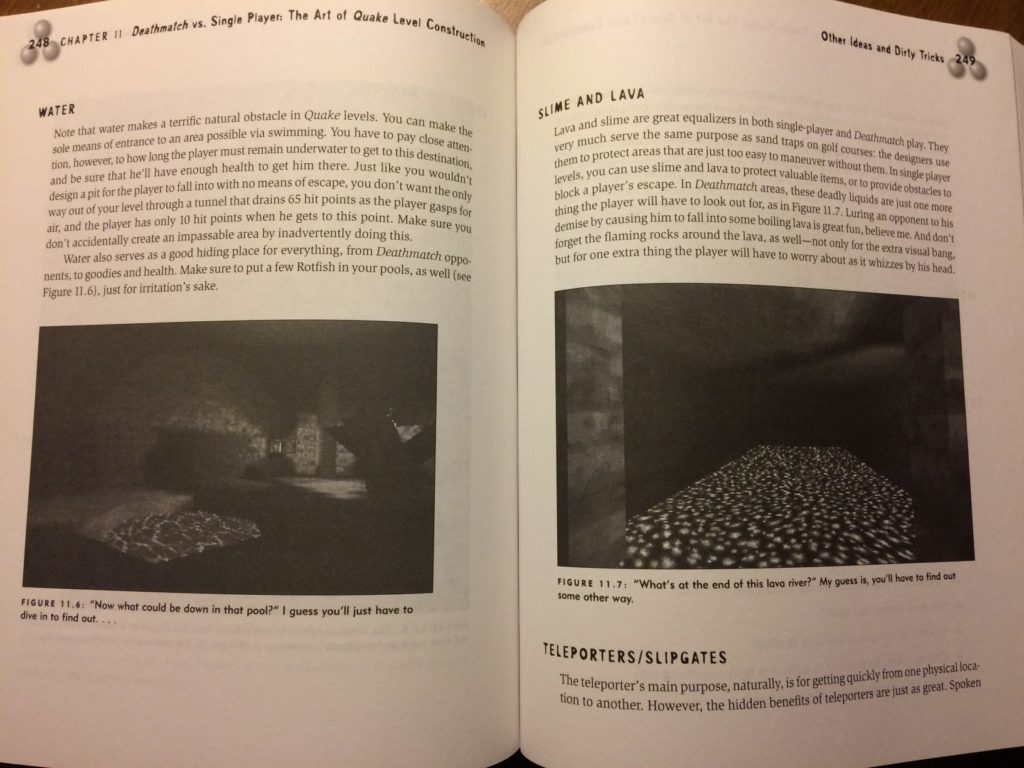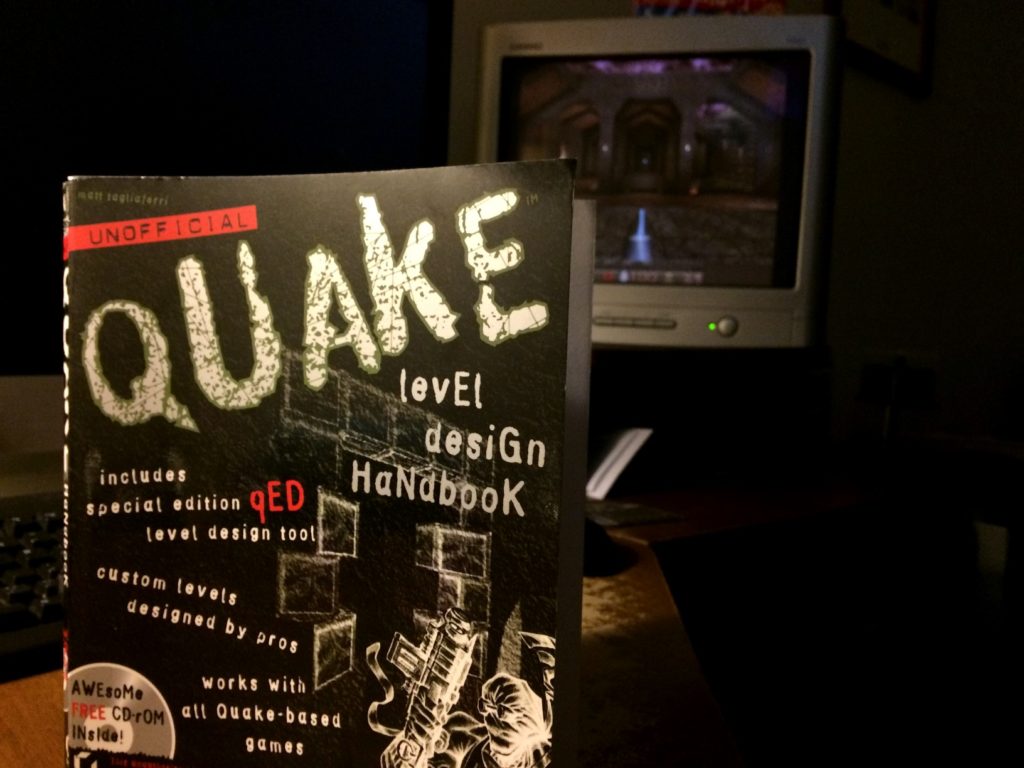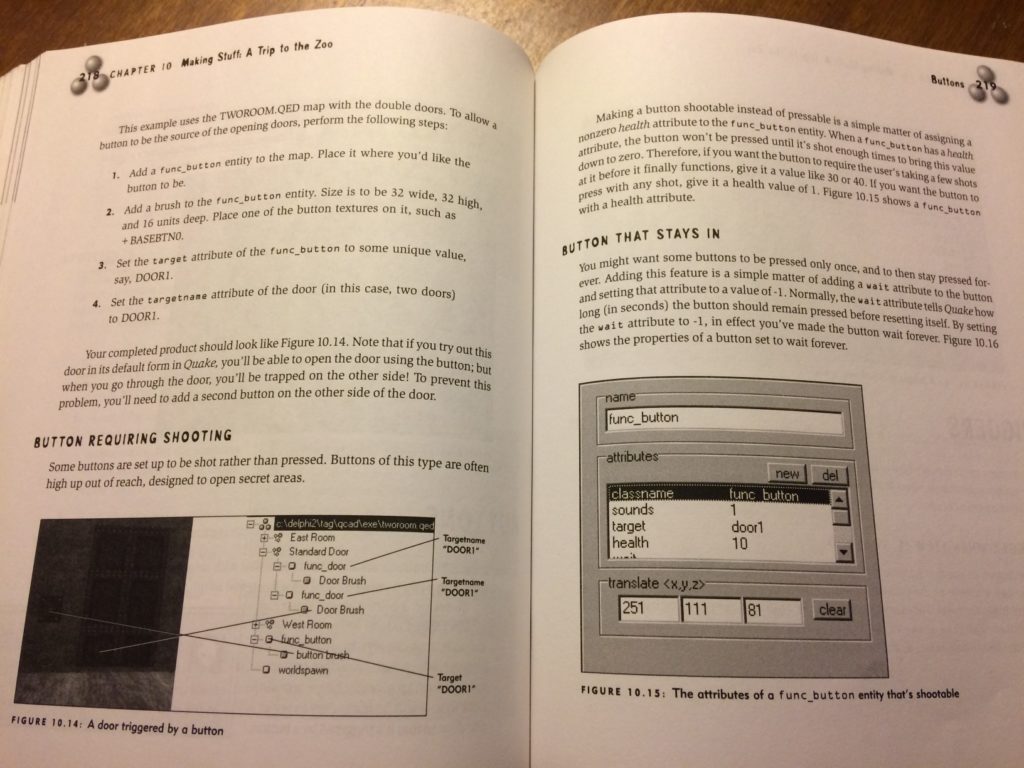The Unofficial Quake Level Design Handbook
- Posted by mariteaux on June 21st, 2020 filed in Modding
- Comment now »
(This post was written with Open Live Writer instead of the normal block WordPress editor I use. Can’t say I’ll continue to use it after it squished my images, ignored the alt text I’d set, and just wasn’t terribly comfortable to use. I also came back hours later to find a bunch of the post missing after I’d shared it out already. Lovely. I can’t say I recommend it.)
A long time ago, we used to be friends, but I…haven’t thought of you lately at all…indeed, as I was going through my materials, I stumbled across a book I actually picked up at the tail end of my experiences with the Quake scene, and that’s Matt Tagliaferri’s Unofficial Quake Level Design Handbook from 1997.
I find old computer books more enthralling than the actual machines at times. Indeed, if you’ll indulge me in reaching into my awkward, sad past, when I was a little kid, long before the age of retrocomputing YouTube, I actually used to collect the old For Dummies… books, the ones before they diversified into general hobby and lifestyle stuff. These were something of a comfort as I was bounced around to psychiatric hospitals; might’ve been alone, but at least I could read about Netscape and SCSI and iBooks.
Computer books were a lot more of a going concern in the pre-“just get it on the internet” era. Indeed, how were you supposed to get online help when you potentially weren’t even online yet? Nowadays, they’re just time capsules, relics I don’t think you can quite get the same feel for if you’re just browsing the Internet Archive. While it’s nice to have working mirrors of some very long-gone sites, modern browsers are a little funny about the experience (none of them play MIDI, as an example), while naturally, a book stays the same no matter what. In the case of my Netscape book, the screenshots often predate anything the Wayback Machine has available (1994 and 1995, while the Wayback Machine started in 1996).
That brings us to this book. While there were places online to get your modder tools (especially since it was all fan-built), by the time Duke Nukem 3D and Quake were taking over, companies were starting to get in on the level editor game, selling unofficial boxed editors that claimed to be easier and more fun to use. That was often not true. My favorite example is an editor I picked up on CD, loose (no box) off Amazon for the purposes of archiving on VDU, Virtus Deathmatch Maker. It’s neat to see the artwork and the way these companies tried their hardest to evoke the spirit of the game without stepping on id’s toes as far as copyright went, but as far as the actual software itself, it’s junky, least on Windows 10.
qED is another one of these aftermarket editors, and one that’s awfully hard to find information on. It was apparently put together by a team called 3D Matrix; they’re long gone, but here’s an archived site. They’re better known as the people behind QME, a model editor that still comes up in the talks about custom Quake models, one of these Milkshape 3D-type dedicated-to-gaming low-poly modelers that’s frankly even more annoying to use than Blender. In any case, this book is tailored to qED. The book was supposed to come with a “special edition” qED on CD-ROM, the only special bit being that it’s shareware that claims it isn’t:
The CD-ROM that comes with this book contains a Special Edition of qED, the powerful Quake Level Construction software for Windows 95. This is not a demo, nor is it shareware—qED Special Edition is the full version of the software. The only limitation is the number of brushes that you can export. You can make and save levels big enough to show off your creative genius and send to friends for internet Deathmatch mayhem.
My copy didn’t come with this, but you can at least find disc images online of the real thing. Of course, even at the time, this shit was not worth the asking price. For as clunky as the free offerings often were at the time, they were leagues ahead of what nonsense the companies were trying to pass off as a workflow. If you want older editors, BSP and Worldcraft are actually vaguely usable, while I have a feeling qED isn’t.
Of course, the basics of Quake editing (solids, point entities, brush entities, compiling) apply to all editors, not just qED. This is where this book’s still solid. There’s a lot of information about nearly all of Quake’s recognized entities, scripting and triggering, texture management, traps and secret areas, tips from the big names in the scene back in the day, like Levelord, and even some rather useful level design theory advice, like on using the third dimension to make better levels:
This is how you should be thinking when you design your levels. This type of three-dimensional thinking will take time to come naturally for you, as well as for you to produce. I recall that the very first Quake levels that started appearing didn’t use the z plane very well: they looked more like DOOM levels converted to the Quake engine. But, as people started realizing all the possibilities, even the most simple levels got more and more interesting, and now we’re starting to see some truly three-dimensional structures, like that shown in Figure 11.4.
Or these bits on how to use each enemy effectively:
monster_shalrathHit Points: 600
Description: This spider-legged monstrosity is known as the Vore in the game. A true menace.
Strengths: Lots and lots of hit points make this critter a problem for most players. He also has a unique attack: a purple firepod that mercilessly tracks its target around corners, into water, up, down, and so on.
Weaknesses: Shalraths don’t move very well on those spindly legs of theirs, but then again, with their heat-seeking attack, they really don’t have to. You can also get them fighting other types of monsters fairly easily, as such creatures can often be lured between a player and the tracking firepod attack.
Ideas for Use: This depends on how ruthless you feel at the time you’re placing them. If you’re in a good mood, you’ll put them in places where the player can take cover behind a column or something, so that he can avoid their damaging firepod. If you’re in a rotten mood, you’ll stick one at the end of a long straight hallway, where no cover can be found.
Of course, it’s not all accurate. I always find it funny when documentation tries to claim worldspawn’s message value (which is meant for the level name when you hold tab) is “text upon entering the world”. No engine I know of displays the level name on spawn. This lie probably came from some entity definition file, either QuakeEd’s or Worldcraft’s FGDs, and then everyone just repeated it ad nauseum, including here. It was 1997 though, no points deducted. It’s a neat read, even today.

As for the editor though, even at the time, it was a moot point. Companies got wise to this whole modding thing and started developing their in-house toolkits with eventual publication in mind. The Radiant family of editors (one prominent set of Quake level editors I still haven’t used) was id’s own level design tool, and variants of it still find their way into Call of Duty and later idTech games alike. In 1997, Valve simply bought Worldcraft, one of the easiest editors around to use, and packed it in on Half-Life’s CD. They also hired out other prominent community modders; Yahn Bernier, the developer of BSP, went to work for Valve, and BSP was used internally by level designers who preferred it. Robin Walker, one of the developers of the original Team Fortress mod, also got snapped up by Valve as a programmer, where he’s still working today.
Copies of this book are still occasionally available, if you’re diligent. Don’t pay the $81 it’s going for on Amazon right now, obviously, it’s not ambrosia or anything, but if you can get it for cheap, especially with the CD, it’s a nice little reminder of how things once were. I still overpaid for my copy, at $19, but it also wasn’t my Amazon money, so oh well. Always waste other people’s money if you can, kids.


